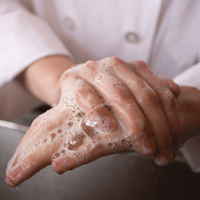Operators beef up their food-safety protocol
You don’t want to be on the receiving end of this phone call. That heart-stopping, panic-inducing call that informs you of a customer who’s fallen violently ill after eating at your establishment and is bedridden or, worse, hospitalized.
At first, you wonder if it could just be a coincidence or frightening false alarm. But, should another, and another, and then another call come in, you might find yourself looking at a recall or a possible closure(s). Should this happen, hopefully, you’ll have the proper protocols at the ready to quickly identify and rectify the issue.
However, what’s preferable is to have carefully enforced, diligent food-safety standards already in place to make sure such a phone call never comes. When you’re focusing on food safety, the old adage “better safe than sorry” is the golden rule in the culinary universe — fortunately, being safe is easier than you think.
Two years ago, the foodservice industry was shaken by a public health crisis when deli meat staple Maple Leaf Foods had to recall numerous products after a listeriosis outbreak — which was traced back to inadequately cleaned meat slicers — killed 22 and made others severely ill. Around the same time, a high-profile E. coli outbreak struck Guelph, Ont., residents who had dined at the local university’s food court.
These types of health emergencies are both an emotional and financial nightmare. No one wants to grapple with the reality of terminating operations and pulling products off shelves, and no one wants to be responsible for a foodborne illness sickening people, or worse.
So how do you prevent it from happening? Surely, you know hand-washing is an essential component of any comprehensive kitchen safety plan. You also know to cook meat carefully and rinse produce thoroughly, as well as to guard against cross-contamination. But there are dozens of little things you may overlook when the dining room is jammed with hungry customers and the restaurant is bustling with flaring tempers, anxious wait staff and all-around kitchen frenzy. Have you brought in the morning’s deliveries? Has the temperature of the hot food been periodically checked for consistency? Did you review a recently arrived order for quality and temperature before the driver sped off to the next store? Is your equipment running properly? If the answer to any of these questions is no, you may be putting your customers — and your livelihood — at risk.
Get Trained // Health Canada estimates that between 11 and 13 million people suffer from food-related illnesses each year. The more common bacteria include E. coli, salmonella and listeria, and though most people who contract these illnesses will recover, some may die. Avoiding such a dire situation is necessary and, fortunately, not particularly complicated — if you know where to start.
“[Foodservice operators] should know the science behind everything,” says Andrew Waddington, a food-safety expert at FS Strategy, based in Mississauga, Ont. “But some don’t know. I’ve seen people leave pork chops out to thaw overnight.”
The “science” Waddington refers to pertains to simple food-handling techniques. Though cooking meat properly may seem like common sense, it may still be a mystery to someone who hasn’t been trained to do it well.
“The best thing to have to protect [the restaurant] is a training program,” says Mike Byerley, director of Quality Assurance at Compass Group Canada. Compass uses the Traincan food safety program to teach operators and chefs about the minutiae of the ever-evolving world of food safety. “Things do change, and as we progress in science, we get better at what we’re doing,” says Byerley. “Chicken used to be cooked at 74°C, and then it was changed to 84°C to kill more bacteria, especially salmonella.”
Byerley recommends Traincan and other programs like it that provide food-safety certification (complete with courses, exams and mandatory three-to-five year certificate renewals), but says that a locally available program approved by a public health office may be a more viable option for small restaurants. Either way, it’s something they should utilize. “The cost of a training program is a lot cheaper than the cost of an outbreak,” he says Scott McDeivitte, a food-safety trainer at Milton, Ont.,-based Gordon Food Services (GFS), says chefs should be trained in what he calls the “time and temperature danger zone. I recommend keeping hot food above 60°C and cold below 4°C,” he says, adding that there are three important stages [in food safety] — Prevent, Delay and Kill. “Too many people focus on the third stage, but all stages are critical, especially prevention.”
Instruments and Organization // “We make sure we train people to take food temperatures correctly,” says Pat Cornacchia, former chef and manager of Kitchen Development at SIR Corp. “A lot of people don’t know the temperatures certain foods should be.”
Cornacchia recommends diligent use of digital biothermometers, and also advocates organizing a kitchen with possible allergies, bacteria and cross-contaminants in mind. It’s simple enough to separate
iceberg lettuce from raw meat, but it requires extra attention to detail to remember to keep salad ingredients from touching a countertop where chicken was previously sliced. “Training courses can teach you where to place items in the fridge, like how eggs should be on the bottom shelf,” he says. “E. coli is a big concern [for us] because we use a lot of chicken. We always tell people to change their aprons after working with raw products.”
All experts stress the importance of being vigilant in verifying the quality of the food. It isn’t limiting to seek out suppliers whose products are subject to routine third-party audits, nor is it rude to inspect new products as they’re being unloaded. The key is to ensure that safety protocol is followed from the back door to the customer’s plate, and that involves being proactive in choosing a supplier.
Good Sense // “Keep checklists so you remember how long food has been around,” says Simon Day, a former chef who teaches restaurant operations at the University of Guelph. “Have high standards for how clean you keep the kitchen. Elevate everyone’s standards by taking personal pride in how you keep the establishment,” he says. “Cross-contamination happens when people just aren’t thinking about it.”
Cleanliness seems simple, but it goes beyond a hairnet. McDeivitte says to treat gloves as a second skin that picks up as much bacteria as a bare hand and, therefore, should be treated like one. It’s also important to be careful with high-risk foods like poultry, beef, eggs and dairy. A colour-coded list may make identifying looming expiration dates easier to remember, as could signs indicating where certain items are to be stored.
Aside from proper hygiene, McDeivitte says it’s also important that sick employees stay home. Salmonella is dangerous, but no patron wants a cold or flu either — especially H1N1, which might still be a concern next flu season.
Trust Inspectors // “We [Guelph University restaurant] get about three inspections a year,” says Day. “But I like knowing that an inspector might stop by anytime.” It’s easy to feel that an inspector is out to get your restaurant, he adds, but the opposite is true. Inspectors can answer your questions, offer advice and help you safeguard your customers and yourself.
“Public health is not your enemy,” says Byerley. “They keep people safe, and they’re there to support you.”
Regular inspections and thorough training and re-training can also function as cheap insurance.
If you follow the guidelines, you’re legally protected should a mishap occur. “[Training and inspections] are a lot cheaper than an outbreak,” he says.




![Redberry Restaurants Becomes Canada’s Area Director for Jersey Mike’s Subs Expansion Redberry Jersey Mike’s Subs - Paul Pascal (left), director of Operations, and Stephen Scarrow (right), senior Marketing manager]](https://www.foodserviceandhospitality.com/wp-content/uploads/2024/04/Redberry-Appointments-218x150.jpg)
















